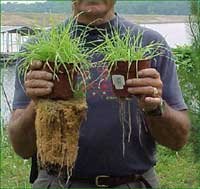The great duos of our society–Peanut Butter and Jelly, Burger and Fries, Hall and Oates–will always be a part of our everyday pleasure. Sure, they’re good apart, but once united, the impact is exponentially infinite. In the growing world, a duos’ impact can turn a meek plot into a thriving garden. One of the best combinations for this transformation is the union of humate and seaweed extracts, more specifically found in Nature’s Nog. This organic growth stimulant was developed by Dr. T.L. Senn, Head Professor of Horticulture at Clemson University, after forty years of research.
How does Nature’s Nog work?
The combination of seaweed and humic acid works because of their compatibility, which in turn gives the plant the ultimate nutrients for growth and development. On the outside, their similarities–environmentally safe and nontoxic–are evident. However, their chemical makeup shows differences, but the rule of opposites attracts comes into play.
Humic acids are the main component of humic substances, which are the main organic members of coal, peat, and soil. Humic acid is not a single acid, but an intricate mixture of many acids, namely Humic, Fulvic, and Ulmic. Humic acid’s best trait is that it is a strong chelating agent. Chelate means to combine nutrients–like calcium, iron, magnesium, and zinc–into an atomic ring, making it easier for the plant to absorb.
Fulvic acid and Ulmic acids greatly influence plant cell division and root development. Fulvic acid goes a step further and helps consolidate micronutrients to plant roots. Seaweed rolls out the green carpet further by providing micronutrients that the humic acids are lacking. It’s also a good chelator as well as giving the plant a strong foundation for pest resistance. Furthermore, seaweed gives the plant “growth vitamins” , such as cytokinins and gibberlins.
The elaborate science in Nature’s Nog simplifies once it reaches the hands of the gardening/farming enthusiast. The simple application instructions (available in both granular and liquid forms) belies the fact that once Nature’s Nog hits the soil, an organic complexity begins, creating plants that will be the pride of the grower.


termites pictures of damage says
Termites do leave a variety of signs of their presence, and with diligent inspections you may
be able to tell if you have an infestation and
catch it before too much damage is done.